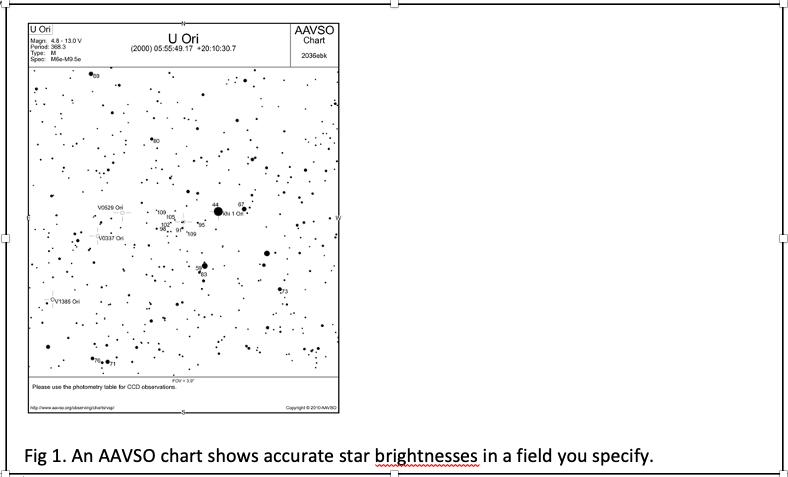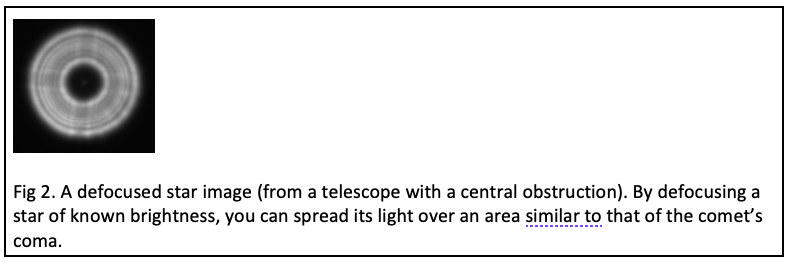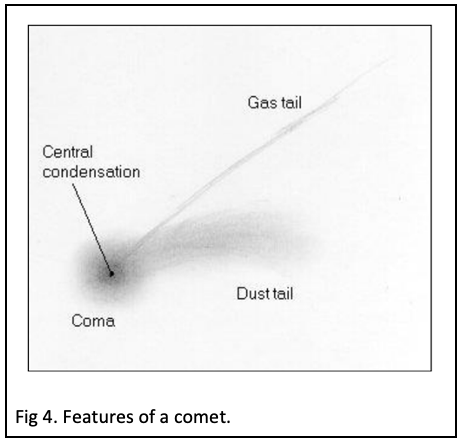2022 November 8
Estimating the Coma Size and Brightness of Comets (Part 1: Visual)
The written content here was authored by Jonathan Shanklin and originally published in the Association’s Comet Observing Guide. Minor amendments to make the article suitable for web publication were made by David Swan.
The full Comet Observing Guide (revision 6) is here.
PART ONE: VISUAL OBSERVATION
Brightness
It can be very difficult to make good magnitude estimates of comets because they are often large and diffuse; practice helps. The observed visual magnitude is dependent on a number of factors including how much defocusing you use and the telescope aperture and magnification. You should use the smallest aperture and lowest magnification that clearly shows the comet. For a comet brighter than 3rd magnitude this will normally be the naked eye.
To make the estimate you use a similar technique to that used for making a variable star estimate. In this situation you choose one comparison star (such as from a variable star chart [Fig. 1]) that is a little brighter than the variable (A) and another that is a little fainter (B). If the variable is closer in brightness to the brighter star then your estimate might be A 1 V 2 B (here the range is divided into three parts); if it is about midway then A 1 V 1 B (the range is divided into two parts), and if closer in brightness to the fainter star then A 2 V 1 B (the range is divided into three parts again). If the variable is much closer to the brighter star your estimate might be A 1 V 3 B (the range is divided into four parts), but it is rarely necessary to divide the range into more than four parts. The brighter star is always given first. If the variable appears identical in brightness to A, then record it as =A. If you can’t see the variable at all, just record the faintest comparison that you can see, for instance if you can see B, but not the variable then record <B OR [B.

To estimate a comet the same procedure is followed, but you have to put the comparison stars out of focus. Select some likely comparison stars from a nearby BAA or AAVSO variable star field or from the Gaia catalogue [see Resources at the end of the article]. For fainter comets it may be preferable to use the North Polar Sequence. Ideally the comparison stars should be in the same field, but this is rarely possible; if they are not you will have to memorise the brightness of the comet and may have to swap between the fields several times.

First centre the comet in the field and try to memorise its appearance. Next choose one comparison star that is a little brighter and another star a little fainter than the in-focus comet and defocus (racking the eyepiece in) until they appear the same size as the in-focus comet [Fig. 2]. Are they still brighter and fainter?, if not choose again! When you are happy, make the estimate in exactly the same way as for a variable star: this technique is known as the Sidgwick (S) method.
As an example, suppose you had used the variable star T UMa (on the BAA VSS programme), and made the estimate: P (1) comet (2) Q (ie the comet is closer in brightness to P). P is mag 9.85, Q is mag 10.29, the difference between them is 0.44. 1/(1+2) of this is 0.15, so the comet is 9.85 + 0.15 = mag 10.00; however we only record it to 1 decimal place, i.e. 10.0.
If you have time, repeat this for another pair of stars because there is often some discrepancy in the magnitudes of the comparison stars from different fields, and several independent estimates will improve the accuracy of the magnitude determination. If the observation is uncertain for any reason (for example discrepant comparison star magnitudes, poor sky conditions etc), always note the magnitude as approximate by putting a colon (:) after it.
Where possible use comparison stars from the AAVSO variable star atlas, a BAA variable star chart, the Tycho catalogue or the North Polar sequence. Always give the source of the comparison star magnitudes, but there is no need to record the actual estimate on the report form, unless you do not have a suitable catalogue or atlas. In this case show the stars you have used by means of a field sketch on a separate sheet.
There is always a great desire to be the first to see a returning comet, the last to see a departing one, or to push the limits of the telescope and observer’s capability. The ready availability of PC planetarium programs with the ability to plot comet paths against Hubble or Hipparcos star fields make it very easy to observe exactly where a faint comet should be. Looking for this faint smudge of light at the limit of the telescope’s light grasp it is possible to convince oneself that something is there and to produce an observation of it. It may well be there, but such observations should always make it quite clear that there is some uncertainty by putting a colon (:) after the magnitude and noting the observation as reliability 3 [Fig. 3]. Comets do outburst and others fade more slowly than expected, but quite a number of observations are appearing on the Internet, which appear to contradict CCD observations and visual observations made with larger apertures. These contradictory observations are often made with moderate apertures and the magnitudes quoted are usually at the limit of the telescope light grasp. They may be true, however the human imagination is a powerful thing.

Coma Diameter
Most comets don’t start to form a coma [Fig. 4] until they are less than three astronomical units (au) from the sun. As the comet approaches the sun, sublimation of ices normally increases and the coma grows larger. If the comet approaches very close to the sun, the coma may appear to shrink again, though this is probably due to increasingly poor observing conditions. The apparent size of the coma depends on the distance from the earth and the true diameter of the coma. Measuring the diameter of the coma is quite important as it gives some physical information about the comet and also gives a comparison between the sky conditions of different observers.

The simplest way to measure the coma diameter is to compare the coma with a pair of stars of known separation. It is easiest to use two stars in the same field as the comet. Their separation can be measured later from an atlas or star chart, calculated from the star’s positions or found by using a PC planetarium program. For a quick estimate, Mizar and Alcor form a convenient yardstick: the separation between Mizar and Alcor is 11.8′, and Alcor to its 8 m companion is 6.3′. Thus if the coma appears to be 2/3 of the separation between Alcor and its companion, the diameter is 6.3 * 2 / 3 = 4.2′.
Please make a measurement or estimate of the coma diameter at the same time and with the same instrument as the magnitude estimate. This is very important for the analysis of the observations as the coma diameter also gives information about your observing conditions. For an elongate coma, report the smaller dimension as the diameter and the longer radius as the tail length. Always measure the magnitude and coma diameter with the same instrument (which may be the naked eye, binoculars or telescope) and only report this instrument. If you make additional measurements of magnitude, coma diameter etc with different apertures, report them separately.
Submitting Your Observations
The Comet Section recommends that you register on the COBS website (preferably as a BAA observer) and submit your observations there. New observers should consider first submitting observations to the Section, so that Section Officers can provide advice where needed. If your observations are submitted to COBS as a BAA observer, the Section can easily download the information for analysis as required.
See the full Guide (section 3.9) for more information about submitting observations.
Teaser image
Comet 2017 K2 PanSTARRS imaged from Siding Spring, Australia by Martin Mobberley and originally uploaded 2022 September 13. At the time, the comet was in Scorpius. A ghostly kinked gas tail is visible to the east of the head.
RESOURCES
These are links to external sites.
Charts with comparison stars for current bright comets: comets-charts (shopplaza.nl)
AAVSO Variable Star Plotter. Plug in the celestial coordinates and FoV: AAVSO — Variable Star Plotter
| The British Astronomical Association supports amateur astronomers around the UK and the rest of the world. Find out more about the BAA or join us. |
